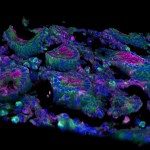Link to Pubmed [PMID] – 8806543
Virology 1996 Sep; 223(1): 89-102
African green monkeys (AGMs) are divided into four species (Cercopithecus aethiops, C. pygerythrus, C. sabaeus, C. tantalus), each harboring a species-specific simian immunodeficiency virus (SIVagm). Little is known about the host and/or viral factors that are responsible for the apathogenicity of SIVagm infections in their natural hosts. In order to analyze the specific selective pressures exerted by the host on the virus in vivo, we compared the genetic evolution of SIVagm.tan in its natural host (C. tantalus) and in a foreign host species (Erythrocebus patas), in which we could obtain a reproducible and persistent infection by SIVagm.tan. As in AGMs, patas monkeys do not develop any disease following SIVagm infection. Our longitudinal study in env (V3-C3-V4-C4-V5) of SIVagm.tan from three AGMs and three patas monkeys revealed a high ratio of synonymous to nonsynonymous mutation frequencies (1.5-6.2). These data indicate that the selective pressures for stability exerted by AGMs and patas monkeys on SIVagm override positive selection for change reported in pathogenic HIV-1 infections. The rapid accumulation of mutations observed in AGMs and patas monkeys (0.4-7.2 x 10(-2) nucleotide substitutions per site per year) suggests a continuous replication of SIVagm viruses in vivo. We thus propose that nonpathogenic SIVagm infections are the result of a long-term selection of SIVagm variants whose dissemination can be controlled in the host, rather than being explained by a low ability of the virus to replicate in vivo.

